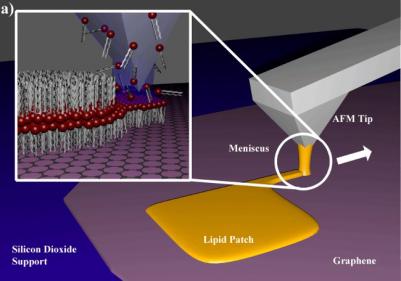Researchers from the University of Manchester demonstrated how membranes can be "written" on to a graphene sheet surface using a technique known as Lipid Dip-Pen Nanolithography (L-DPN). The researchers have shown that graphene is a great surface for human-cell membrane research. Graphene combined with lipids may also enable new types of bio-sensors.

The researchers wanted to find a new way to study human cell phospholipid bi-layer membranes, which protect the cells.The membranes contain proteins, ion channels and other molecules, each performing vital functions. Researchers already developed model cell membranes on surfaces outside the body for research purposes. The new research have shown that graphene is a great surface to assemble said membranes and research them.
The new technique uses an Atomic Force Microscope (AFM), which has a very sharp tip with an apex in the range of several nanometers as a means to write lipid membranes onto surfaces in a way similar to what a quill pen does with ink on paper.